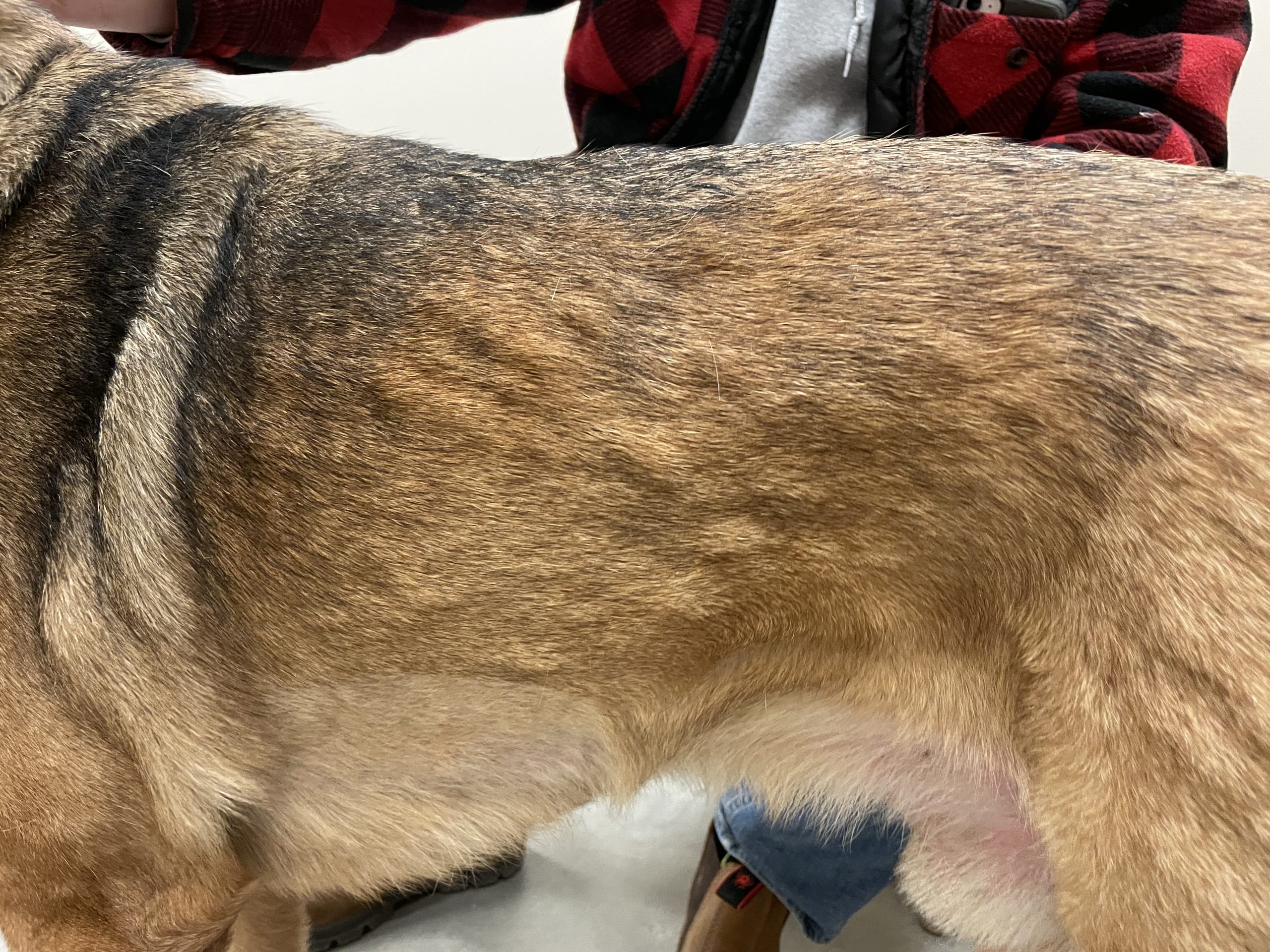Allergy Testing & Desensitization
Discovering your pet’s environmental triggers
Testing. That’s how we get to the root of the issue. We offer both intradermal skin and serum allergy testing to patients once we have confirmed the diagnosis of atopic dermatitis. Based on these results, we formulate allergen-specific immunotherapy and begin desensitization. The most common environmental allergens include house dust mites, pollens from trees, grasses, weeds, and molds. Currently there is no accurate food allergy testing available in veterinary medicine which means our testing identified environmental allergens only.
Our allergy testing is done by looking at your pet’s immune response to particular environmental allergens. There are two ways to perform allergy testing:
Intradermal skin test: in some ways the most accurate test. This test is done under light sedation, followed by the injection of over 50 different allergens. The allergens that cause reactions (wheals or large bumps) are the ones we identify as triggers for your pet.
Serum allergy test: It is very important this test be done at the right time for each pet – if the test is run at the wrong time it may be negative despite the patient being allergic. This blood is taken in-clinic and the test is sent to an outside lab.
The goal of allergy testing is not to ‘diagnose’ an allergy in your pet. Initially, PetDerm will determine a clinical diagnosis of Atopic Dermatitis – or hypersensitivities to environmental allergens. Once the diagnosis is made, the purpose of the allergy test is to formulate an immunotherapy for your pet. Immunotherapy (allergy shots (SCIT) or allergy drops (SLIT)) consists of micro dosing your pet with what it is allergic to over time. This will create immune-tolerance where your pet gets used to the allergen and controls the symptoms of the allergy.

How to book this service?
It starts with a Dermatology referral. Please ask your family veterinarian for a referral. Send your veterinarian a referral request to get your initial consultation booked!
We understand you may be struggling to find the help you need for your special pet. We want to help so we created a self-referral process for an internal medicine consultation.

Frequently Asked Questions
Certain medications and therapy may interfere with the results of intradermal testing. These medications must be withdrawn accordingly prior to the procedure. Please contact your family veterinarian to discuss safe withdrawal from any of these medications.
Medications mostly commonly used in allergic patients that would interfere with intradermal testing:
- Oral, injectable or topical steroids and anti- histamines.
Medications most commonly used in allergic patients that DO NOT interfere with intradermal testing:
- Oclacitinib (Apoquel), Lokivetmab (Cytopoint), Ilunocitinib tablets (Zenrelia), Cyclosporine (Atopica).
Immunotherapy (allergy shots (SCIT) or allergy drops (SLIT)) consists of giving microdoses of the allergens your pet is allergic to, to your pet, over time. We slowly increase the dose and aim to create immune tolerance for your pet. Over time, it trains your pets immune system to become desensitized to the allergens.
Most common symptoms of an allergy include itching, scratching, head flapping and excess licking. Often dogs and cats will experience inflammation of their skin and ear and often experience recurrent and chronic secondary skin and ear infections.
If your pet is experiencing environmental allergies, their symptoms may be seasonal, and change throughout the year. If your pet has concurrent or undiagnosed food allergies, which may occur alongside environmental allergies, they may experience gastrointestinal symptoms such as soft stools, diarrhea, increased bowel frequency, and vomiting.
Allergy testing is not recommended under 1 year of age. In some cases, we may even recommend waiting longer.
Allergy testing for dogs can be done by intradermal allergy test (intradermal skin test) or by blood test. The intradermal test is considered the most reliable. For the intradermal test, dogs are typically lightly sedated (not under general anesthesia), a patch of hair is clipped on the side of the chest and multiple allergens are injected into the skin. Reactions are measured and recorded.
At this time, there is no reliable at-home allergy test on the market. While they are available (using your pet’s hair or saliva), they are not validated nor tested against conventional allergy tests. Most importantly, they don’t provide you an accurate diagnosis nor with a solution for long-term allergy management.
For food allergies, unfortunately, no blood, hair or saliva test has been shown to reliability diagnosis adverse food reactions. Currently, the only reliable diagnostic test for food allergies is an elimination diet trial.
Watch this YouTube video from DVM360 to learn more about debunking at-home allergy tests.
The only reliable way to diagnose food allergies in dogs and cats is through a strict elimination diet trial. While some tests claim to detect food allergies using blood, hair, or saliva, they are not reliable or dependable.
Symptoms of food allergies in dogs and cats may include behaviours such as licking, scratching, chewing, and rubbing various regions like the face, ears, rear, armpits, and other body parts. Additionally some pets with food allergies may present gastrointestinal manifestations such as loose stool and vomiting. Distinguishing food allergies from environmental allergies can be complicated and that is why we are here to help. Diet consultations with a veterinary dermatologist can help your pet enjoy food again!
Serum allergy test is less invasive than the skin test. It is very important this test be done at the right time for each pet – if the test is run at the wrong time it may be negative despite the patient being allergic. This blood is taken in-clinic and the test is done at an outside lab. The only reason to do allergy testing in a pet is to use the results to begin immunotherapy and desensitize your pet to their environmental allergies.
Atopic dermatitis in dogs and cats is a chronic, inflammatory skin condition caused by sensitivities to environmental allergens such as pollens from trees, weeds and grasses, common dust mites, or mold. It often results in itching, redness, hair loss, and skin and ear infections.
Diagnosis involves a combination of history, clinical signs, and ruling out other skin conditions. Accurate diagnosis is crucial for managing symptoms and improving the quality of life for pets with this condition.
Learn more about Atopic Dermatitis and it’s symptoms, on the Empathy for Itch initiated by The Canadian Academy of Veterinary Dermatology (CAVD).
The goal of allergy testing is not to ‘diagnose’ an allergy in your pet. A diagnosis is made with a dermatological history, a dermatological exam, ruling out other causes of itching, and coming to the clinical diagnosis of Atopic Dermatitis – or hypersensitivities to environmental allergens. Once the diagnosis is made, the purpose of the allergy test is to formulate an immunotherapy for your pet. Immunotherapy (allergy shots (SCIT) or allergy drops (SLIT)) consists of microdosing your pet with what it is allergic to over time. This will create immune-tolerance where your pet gets used to the allergen and the symptoms are reduced or resolved.
Our allergy testing is done by looking at your pet’s immune response to particular environmental allergens. There is no accurate food allergy testing available in veterinary medicine which means our tests looks for environmental allergens only. There are 2 ways to perform allergy testing:
Intradermal skin test: in some ways the most accurate test. This test is done under light sedation, followed by the injection of over 50 different allergens in between the layers of the skin (intradermal). The allergens that are causing reactions (wheals- or large bumps) are the ones we identify as triggers for your pet.
Serum allergy test: This is less invasive than the skin test. It is very important this test be done at the right time for each pet – if the test is run at the wrong time it may be negative despite the patient being allergic. This blood is taken in-clinic and the test is done at an outside lab. We recommend you speak with a veterinary dermatologist before you have any serum test done.
Explore Other Services



